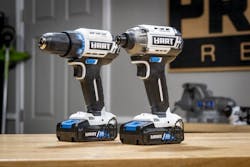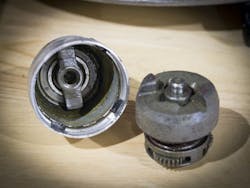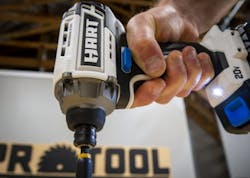Impact drivers 'hammer' screws into wood
What is an impact driver, and what do you use it for? It’s a question we all had to learn the answer to at some point, and we’re glad to help you out! Whether you’re adding to your personal tool collection or you’re new to the construction industry, they are incredibly useful tools and are becoming more versatile.
Let’s start with the basics: what exactly is an impact driver?
Like a drill, an impact driver spins a bit. It uses an internal mechanism called a hammer and anvil to turn whatever you load in the collet (the impact driver version of a chuck). The hammer strikes the anvil, creating an impact and forcing rotation.
Most impact drivers have two hammers and two anvils. Metabo HPT has a couple of models with three. Some are capable of creating more than 4000 impacts per minute thanks to speeds that are higher than drills!
Some people refer to an impact driver as an impact drill. Most of the time they’re referring to the same tool. Some people may be thinking of a rotary hammer, but that’s less common.
WHAT IS THE DIFFERENCE BETWEEN AN IMPACT DRIVER AND A DRILL?
There are several key differences between an impact driver and a drill. The main one is that a drill uses steady rotation and creates a smooth turning motion. An impact driver uses the hammer/anvil mechanism and turns as the impact happens.
Another big difference is how they hold bits. A drill has a chuck with teeth that close in and open up as you twist it. An impact driver has a 1/4-inch hex collet that you pull out to insert or release a bit. When you let it go and it springs back into place, the bit locks in.
Because of the design differences, impact drivers are usually lighter and more compact, but the impact vibration is very noticeable compared to a drill.
There are other differences to consider as well. Read more about them here.
Impact drivers are mostly useful for heavy construction
An impact driver is the fastening king of most tool collections. Whether you’re building a deck, installing hinges, running long screws, or doing a host of other wood and metal fastening chores, there’s a good chance your impact driver will be your go-to tool.
There are some times you shouldn’t use it, though. For example, the high speeds and violent impacts they generate aren’t great for small screws like the ones you use on cabinets.
In recent years, accessory manufacturers have put 1/4-inch hex shanks on drill bits, spade bits, and even step bits along with a handful of others. That makes the impact driver even more versatile because you can make holes in addition to driving screws. Just be aware that the impacting creates more vibration in the handle, so it won’t feel as smooth as a drill.
HOW DO YOU USE AN IMPACT DRIVER?
Using an impact driver is similar to using a drill with a couple of major differences. The first we already talked about—is how you load the collet. Pull it out to load or unload your bit and let it spring back into place to lock the bit in. It’s perfectly okay to give the bit a little tug to make sure it’s secure.
Many impact drivers have multiple modes. If you’re used to the way a drill works, it’s a bit different. On a drill, as you shift to the high-speed gear, you lose torque as a consequence. When you put it in the low-speed gear, you get more torque.
On an impact driver, low speed also has the lowest torque. As you move up to higher-speed gears, you get more torque.
Once you match the bit with the hole you want to drill or fastener you want to drive, select which gear you want to use (if available—some are single-speed), and pull the trigger.
The trigger on most is a variable speed design, meaning it speeds up the more you pull it. Pull the trigger gently at first to help you control the start and ensure you’re going in straight. Once you are, go ahead and pull the trigger all the way in until you’ve completed your hole or drive.




